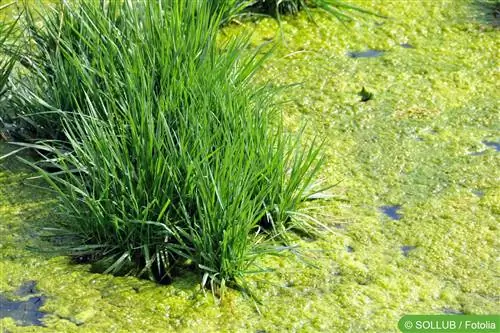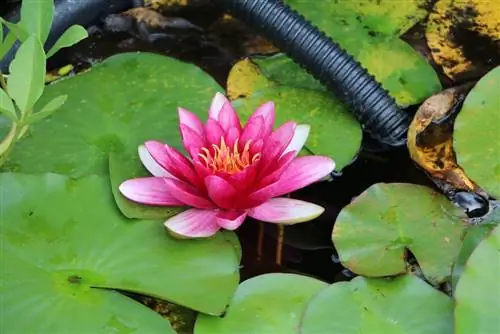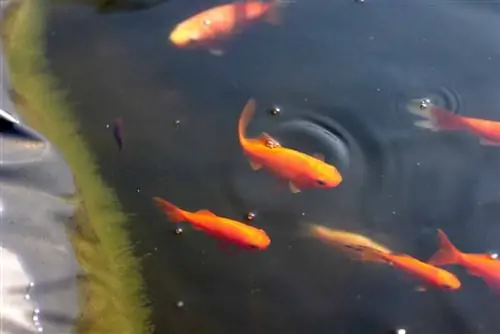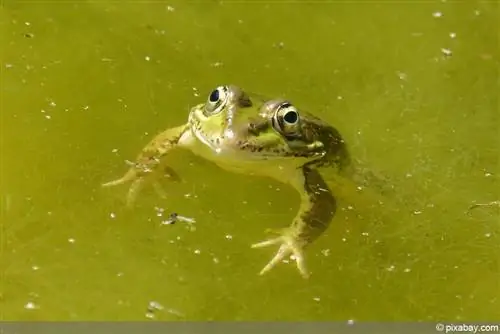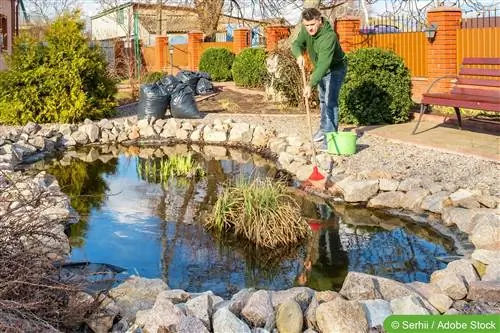- Author admin [email protected].
- Public 2023-12-17 03:39.
- Last modified 2025-01-24 12:45.
The garden pond or swimming pond is the flagship of a garden or facility. Especially in the swimming pond there should be no visually disturbing algae, which can also hinder swimming.
Algae can usually be recognized by its slightly greenish shimmer. In most cases these are caused by green or blue-green algae. However, with these two types of algae the water remains clear. Water fleas can be used in garden ponds. These are harmless to humans. However, you really have to worry if the pond or swimming pond is infested with thread algae. When thread algae multiply rapidly, it can cloud the water. Other plants that are in the pond die and consequently sink to the bottom of the pond. These begin to decompose on the ground. Decomposition processes now begin, which leads to a decrease in the oxygen concentration in the pond. This can cause the body of water to tip over and fish in it to die.
Types of algae that are found in the garden pond
There are a variety of different types of algae in garden ponds or swimming ponds. In addition to various green and blue algae, the filamentous algae, microalgae and floating algae are also found here. As a rule, these live there in coexistence with many fish and plants, provided that the nutrient concentration of the water is optimal or normal. However, when the phosphate concentration rises above 0.035 milligrams per liter, the algae's living conditions are extremely improved. If there is also sunlight, the algae can multiply explosively. This explosive proliferation is called an algal bloom. This algae bloom means that other creatures in the pond can no longer receive the nutrients they need.
The role of phosphate in the pond
Phosphates can get into swimming ponds and garden ponds in very different ways. However, it is usually the phosphates from fish feed that cause an excess of phosphates. Many types of fish such as bitterlings, goldfish or sticklebacks find enough food in the pond to survive without additional food. If there are only these types of fish in the pond, additional feeding is not necessary, as is the case with koi, for example. But there are also phosphates in the fish droppings, which sink to the bottom of the pond like the excess food. They can also get into the water via fertilizers or during heavy rainfall. But leaves and dead plants that sink to the bottom of the pond also contain phosphates, albeit only in small amounts. But it also contains other nutrients that ensure increased algae growth.
Removing the breeding ground from algae
Problematically, it's not just the algae that need phosphates to thrive. Other living creatures in the pond also rely on phosphates, nitrates and other nutrients. In principle, it can therefore be assumed that plants in the pond claim the phosphate and other nutrients for themselves. In order to remove these plants from the nutrient cycle, the aquatic plants must be cut back. However, the clippings should not remain in the water as they will sink to the bottom and decompose there.
Algae that are in the pond should be fished out regularly. These can also be composted. In addition, mineral phosphate binders can be used to reduce the phosphate content. Chemical processes ensure that the phosphate is bound to the minerals and can no longer be absorbed by the algae. If there is too thick a layer of sludge on the bottom of the pond, renovating the pond can help. To do this, the water is drained from the pond and the thick layer of sludge, which consists of rotten plants and fish droppings, is removed. This layer of mulch is now replaced by a nutrient-rich substrate. Here too, the plants are cut back.
Keep pond water permanently clear
If you want to have a permanently clear, algae-free pond, you should ensure that all phosphate sources are removed. The course for this is usually set when the pond or swimming pond is created. A slightly elevated place should be chosen to create the pond, even if it doesn't look natural. This slight increase prevents fertilizers from the surrounding area from being washed into the pond. A trench of 50 to 100 cm acts as an additional buffer. Coarse-grained building sand should be filled into this trench. In addition, the location should be chosen so that it is in partial shade. Although sunlight does not directly increase the proportion of phosphate in the water, it does promote algae growth. In addition, the diameter and depth of the pond and bathing pond have an influence on algae formation. The shallower and smaller a pond is, the more often problems with algae occur. The pond soil should consist of nutrient-poor sand. The water with which the pond is filled should be tested and contain less than five milligrams of phosphate per liter of water. Nutrient-rich deposits in the pond should be removed with a pond sludge vacuum. In autumn it can make sense to cover small ponds with a net. This means no leaves fall into the pond or swimming pool.
Keep phosphate content low in the fish pond
Aquatic animals such as fish or newts produce excretions that also contain phosphate. As a rule, these excretions are harmless. However, if fish food is overfed, additional phosphates and other nutrients enter the pond, which can also be absorbed by the algae. For this reason, you should only keep as many fish in the pond as the pond can support. If it still needs to be fed, installing additional filter systems can help remove algae and excess nutrients from the garden pond. This is especially the case with fish, such as koi fish, as additional feeding cannot be avoided.
What you need to know about biological algae control
If the outside temperatures are already higher at the beginning of spring and there is only little precipitation, there is usually a risk of increased algae formation in the ponds of your home gardens. This observation can be made even in biotopes with a rather low oxygen or nutrient content. The following are particularly widespread:
- Yoke algae,
- Thread green algae
- Blue-green algae
For the owner of an artificially created biotope, algae usually doesn't mean anything good, quite the opposite: a lot of work combined with a lot of time to remove these sometimes annoying green growths from the water and from the other plants (water lilies, etc.) and the (stone) border must be removed. But what can be done to stop algae growth?
- UVC devices are a biological and quite efficient solution, but they are suspected of causing cancer.
- Completely renewing the water in the garden pond is certainly more complex, but much more effective.
- Algae-eating fish species are ideal for curbing excessive algae!
- The same good services are also provided by nutrient-consuming aquatic plants, such as: B. Echinodorus or the Cryptocoryne.

